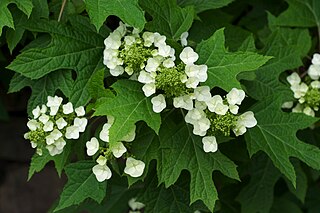
Hydrangea quercifolia, commonly known as oakleaf hydrangea or oak-leaved hydrangea, is a species of flowering plant in the family Hydrangeaceae. It is native to the southeastern United States, in woodland habitats from North Carolina west to Tennessee, and south to Florida and Louisiana. A deciduous shrub with white showy flower heads, it is grown as a garden plant, with numerous cultivars available commercially.

Euphorbia amygdaloides, the wood spurge, is a species of flowering plant in the family Euphorbiaceae, native to woodland locations in Europe, Turkey and the Caucasus. It is a bushy evergreen perennial, growing to a height of 80 cm (31 in), with dark green slightly hairy leaves about 6 cm (2 in) long. The complex green-yellow inflorescence (cyathium), typical of Euphorbia, appears in late spring and early summer.

Lavandula angustifolia, formerly L. officinalis, is a flowering plant in the family Lamiaceae, native to the Mediterranean. Its common names include lavender, true lavender and English lavender ; also garden lavender, common lavender and narrow-leaved lavender.

Geranium sylvaticum, the wood cranesbill or woodland geranium, is a species of hardy flowering plant in the family Geraniaceae, native to Europe and northern Turkey.

Vinca major, with the common names bigleaf periwinkle, large periwinkle, greater periwinkle and blue periwinkle, is a species of flowering plant in the family Apocynaceae, native to the western Mediterranean. Growing to 25 cm (10 in) tall and spreading indefinitely, it is an evergreen perennial, frequently used in cultivation as groundcover.

Trillium luteum, the yellow trillium or yellow wakerobin, is a species of flowering plant in the bunchflower family Melanthiaceae with native populations in the Great Smoky Mountains of the United States and surrounding areas.
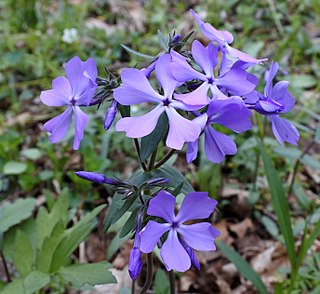
Phlox divaricata, the wild blue phlox, woodland phlox, or wild sweet william, is a species of flowering plant in the family Polemoniaceae, native to forests and fields in eastern North America.

Polygonatum multiflorum, the Solomon's seal, David's harp, ladder-to-heaven or Eurasian Solomon's seal, is a species of flowering plant in the family Asparagaceae, native to Europe and temperate Asia. In Britain it is one of three native species of the genus, the others being P. odoratum and P. verticillatum.

Erythronium californicum, the California fawn lily, is a species of flowering plant in the family Liliaceae, endemic to moist woodland habitats in the mountains of Northern California.

Ornithogalum nutans, known as drooping star-of-Bethlehem, is a species of flowering plant in the family Asparagaceae, native to Europe and South West Asia. It is a bulbous perennial growing to 20–60 cm (8–24 in) tall by 5 cm (2 in) wide, with strap-shaped leaves and green striped, pendent grey-white flowers in spring. It is cultivated, and has naturalized, outside its native range, for example in North America. It has become extremely invasive along the Chesapeake and Ohio Canal in Maryland. At least in North America, it is not as common as Ornithogalum umbellatum.
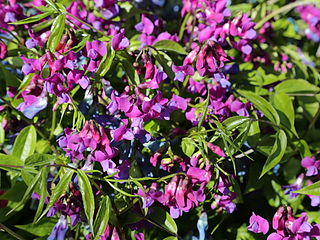
Lathyrus vernus, the spring vetchling, spring pea, or spring vetch, is a species of flowering herbaceous perennial plant in the genus Lathyrus, native to forests of Europe and Siberia. It forms a dense clump of pointed leaves with purple flowers in spring, shading to a greenish-blue with age.

Hylotelephium cauticola, the cliff stonecrop, syn. Sedum cauticola, is a species of flowering plant in the family Crassulaceae, native to Hokkaido, Japan. Growing to 8 cm (3 in) tall by 30 cm (12 in) wide, it is a carpet-forming succulent perennial with trailing stems of pink-tinged grey-green round leaves, and purplish pink star-shaped flowers in autumn.

Salvia fulgens, the Cardinal sage or Mexican scarlet sage, is a species of flowering plant native to the Mexican mountains adjacent to the state of Puebla, growing at 8,700-11,000 ft elevation. It prefers the edge of oak and coniferous woodlands, especially in clearings of Abies religiosa. The mountains receive fog and rain nearly year-round.

Lewisia cotyledon is a species of flowering plant in the family Montiaceae known by the common names Siskiyou lewisia and cliff maids. It is native to southern Oregon and northern California, where it grows in rocky subalpine mountain habitat.
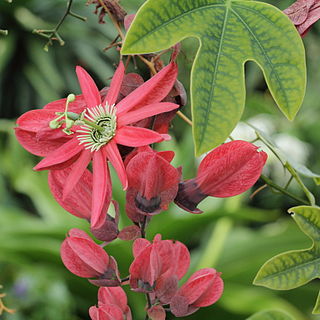
Passiflora racemosa, the red passion flower, is a species of flowering plant in the family Passifloraceae, native to Brazil. It is an evergreen climber growing to 5 m (16 ft), with simple or 3-lobed leaves to 10 cm (4 in) long, and vivid red flowers borne in summer. The flowers are 12 cm (5 in) in diameter, with purple and white coronas. They are followed by oblong green fruits.

Daphne arbuscula is a species of flowering plant in the family Thymelaeaceaecae, native only to Slovakia. It is endemic species of Muránska planina National Park. It grows on sunny rocky slopes and rock terraces, mostly on sites with a south or southwest exposure, on limestone bedrock, at an altitude of 800–1300 m. It is a dwarf evergreen shrub growing to 15 cm (5.9 in) tall and broad, with narrow dark green leaves and highly fragrant pink flowers in dense clusters in the spring.

Eucryphia glutinosa, the brush bush or nirrhe, is a species of flowering plant in the family Cunoniaceae, native to moist woodland habitats in Chile. It is a large deciduous shrub or small tree, growing to 10 m (33 ft) tall by 6 m (20 ft) wide, with glossy dark green leaves turning red in autumn. Single four-petalled, fragrant white flowers with prominent stamens appear in late summer.

Globularia cordifolia, the heart-leaved globe daisy, is a species of flowering plant in the family Plantaginaceae, native to the mountains of central and southern Europe, and western Turkey.

Omphalodes cappadocica, the Cappadocian navelwort, is a species of flowering plant in the family Boraginaceae, native to woodland habitats in Turkey. It is an evergreen perennial growing to 25 cm (10 in) tall by 40 cm (16 in) wide, with slightly hairy, oval pointed leaves and loose terminal racemes of bright blue flowers with white eyes, similar to forget-me-nots, appearing in spring.
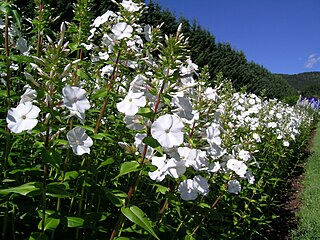
Phlox carolina, the thickleaf phlox, is a species of flowering plant in the family Polemoniaceae. It is an herbaceous perennial growing to 1.2 m (4 ft) tall by 45 cm (18 in) wide, with leaves to 13 cm (5 in) long, and purple or pink flowers in summer. The specific epithet carolina refers to its native habitat in the eastern United States. It grows in woodland edges and openings. Flowers attract bees, hummingbirds, and butterflies.




















